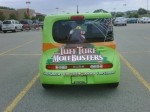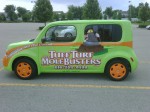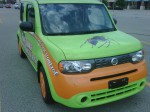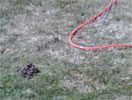We have have trapped over 1000 moles for this season. We currently are trapping about 100 each week.
1000 moles trapped in 2011!
July 27th, 2011 by Tuff Turf MolebustersWelcome Cubert!
June 1st, 2011 by Tuff Turf Molebusters


Cubert joined our team on 5/31/11. He came directly from the Nissan factory. His job is to transport Jim and Jeff to clients’ lawns, as well as the Zylstra children to wherever they may need to go. He is still waiting for his mole “hat” to be placed on his head.
We Have Bad Gas
April 11th, 2011 by Tuff Turf MolebustersCarbon Monoxide to be more specific. We purchased a carbon monoxide compressor. We can inject Carbon Monoxide into the ground at 120 psi per injector at 4 different injection locations. The compressor will fill a 200 foot long mole tunnel with Carbon Monoxide in seconds. Any mole or vole in those tunnels will die within seconds. The gas will travel a couple hundred feet into any tunnels in the surrounding area that is connected to the tunnels in your lawn.
Spring Seeding
March 7th, 2011 by Tuff Turf MolebustersPart I: Spring seeding options
(This turf tip is part of a three part series on spring seeding.)
Seeding in spring is difficult and often unsuccessful. However, there are circumstances that warrant a spring seeding:
*Thin turf due to winter damage
*Poor turf density due to poor recovery from previous year’s problems, i.e., grub damage, drought damage, etc. This is the case in 2011 due to heat and drought in 2010.
*Construction of a new home or business.
If a spring seeding is necessary, consider doing it before the ground thaws from winter. Although it is not necessary to seed before the ground thaws it may make seeding more easy as soils are often soft and moist in the spring which may make it more difficult to seed certain areas, especially with heavier equipment.
Seed planted now will lie dormant until the soil temperatures warm in late March, April or possibly May. Depending on your location in Indiana, dormant seeding can be done as early as Thanksgiving and as late as March. The benefit of dormant seeding is that as the soil heaves and cracks during the winter, crevices are created for the seeds which provide ideal germination conditions. Additionally, dormant seeding is easier to schedule than spring seeding, because spring rains make it difficult to find the right time to seed after March in Michigan. Seed can also be planted in April and May, but a March seeding date will allow more time for root development before summer.
Although any cool-season grass can be seeded in the spring, spring seedings are more successful with tall fescue and perennial ryegrass than with Kentucky bluegrass due to the faster germination rate and better seedling vigor of perennial ryegrass and tall fescue compared to Kentucky bluegrass (Fig. 1). If Kentucky bluegrass is seeded in the spring consider using a mixture of tall fescue: Kentucky bluegrass (90:10, weight: weight) or a mixture of Kentucky bluegrass:perennial ryegrass (such as 80:20, weight: weight)(Table 1). Seeding Kentucky bluegrass alone will result in marginal bluegrass establishment due to the slow germination and vigor of the seedlings and increased competition from crabgrass.

Fig. 1. Germination of perennial ryegrass (left, PR) will be followed by tall fescue (center, TF) and then Kentucky bluegrass (right, KBG).
Species Seeding (rate lbs/1,000 ft2) Days to germinate
Kentucky bluegrass 1.0 to 2.0 10-21
Kentucky bluegrass + perennial ryegrass 3.0 to 6.0 5-21
Tall fescue 8.0 to 10.0 6-10
Fertilizing
New turfgrass seedlings have poorly developed root systems and thus they cannot affectively take up the nutrients from the soil. Therefore, frequent Lawn Fertilizing is important after seeding to encourage establishment. To help the turf establish, apply a “starter fertilizer” to enhance seed germination and development. Starter fertilizer is high in phosphorus which is listed as the second number in the analysis on the fertilizer bag. For instance, a 16-22-8 fertilizer contains 22% P2O5. Apply the fertilizer according to the label directions would should supply at least 1.0 lb. P2O5 /1000 ft2. This application will likely include nitrogen (first number in the fertilizer analysis), which will also help the turf develop an extensive fibrous root system that is better able to take up nutrients and obtain water.
Winter Mole Activity
February 25th, 2011 by Tuff Turf MolebustersLast week when the weather warmed up and the snow melted for a day or two our phones were ringing off the hook! Customers were calling in to sign up for mole control programs because the melting of the snow uncovered yards full of mole trails. It sounds like there was a lot of mole activity going on this winter! One of our frequently asked questions is “Moles are dormant in winter, right?” In fact moles don’t hibernate nor do worms. The moles follow worms deep into the ground as both try to avoid freezing. Most of the moles deeper (older) tunnels remain comfortable throughout the winter. Winter damage by moles usually occurs during unseasonably warm periods or beneath the insulation of heavy snow. Moles can’t hibernate because they don’t store food or fat. This fact shows the importance of a good mole control program during the summer so that the moles don’t continue to repopulate and further damage your lawn during the winter.
Boosting the Local Economy
February 4th, 2011 by Tuff Turf MolebustersHere’s some information I came across in a recent edition of Lawn and Landscape magazine. I think it’s some excellent information.
Boosting the local economy
Buy local. Though certainly not a new idea, supporting local businesses has received a push from a national movement of independent business owners that have formed Independent We Stand to educate their communities on the benefits of shopping at neighborhood stores. Independent We Stand is funded in part by STIHL.
The movement uses recent surveys to break down the benefits of buying from local businesses. According to the group:
If you spend $100 at an independent business, $68 returns to the local community. Spending the same amount at a national chain equates to $43 back to the community.
Small businesses create 75 percent of all new jobs and half the non-farm private gross domestic product.
Locally owned businesses reinvest in its communities economy at a 60 percent higher rate than chains and Internet retailers.
Locally owned and operated businesses provide higher-paying jobs.
Finally, more tax dollars are reinvested in the community to fund essentials such as schools, fire and police and road improvements.
“This project began as a way to inform friends and neighbors on one of the best ways to revive our economy: buy local,” says Bill Brunelle, spokesperson for Independent We Stand.
“Buying products and services from people who work and live in your town means more money goes back to your local area,” he says.
2011 Mole Renewals
January 27th, 2011 by Tuff Turf MolebustersExisting mole clients can look for their mole renewal in their email yesterday or mailbox early next week.
3 more moles
January 11th, 2011 by Tuff Turf MolebustersWe found 3 frozen moles in traps under the snow. That is a good way to preserve them!
Moles from Arkansas
January 11th, 2011 by Tuff Turf MolebustersHey Jim,
We had a live mole in one of our traps the other day. I have attached a short video we shot of the mole. Feel free to use it if you would like.
Thanks for all your help
John Glover
Superior Lawn Services
Jonesboro, Arkansas
TRIP Programs
December 20th, 2010 by Tuff Turf MolebustersTuff Turf Molebusters now gives 10% back to local schools by participating in the T.R.I.P. programs of Calvin, Unity, Jenison, Hudsonville, Grand Rapids, and South Christian High School. If you have children attending one of these schools or the feeder schools, contact the TRIP office at the school for more details.

